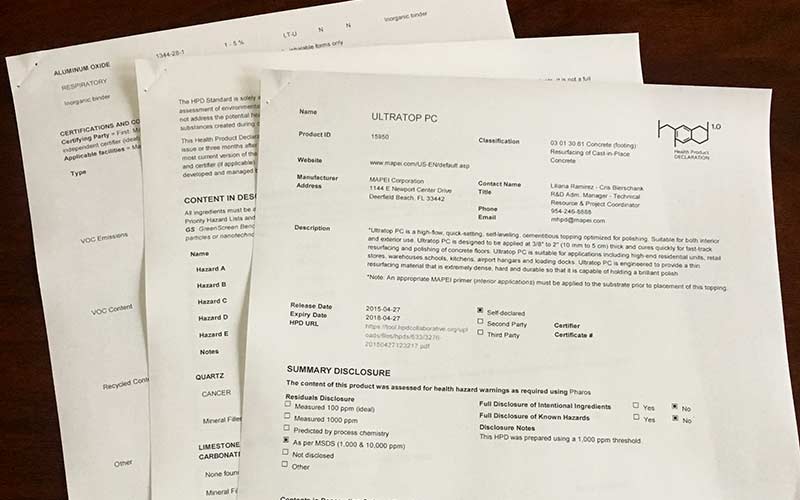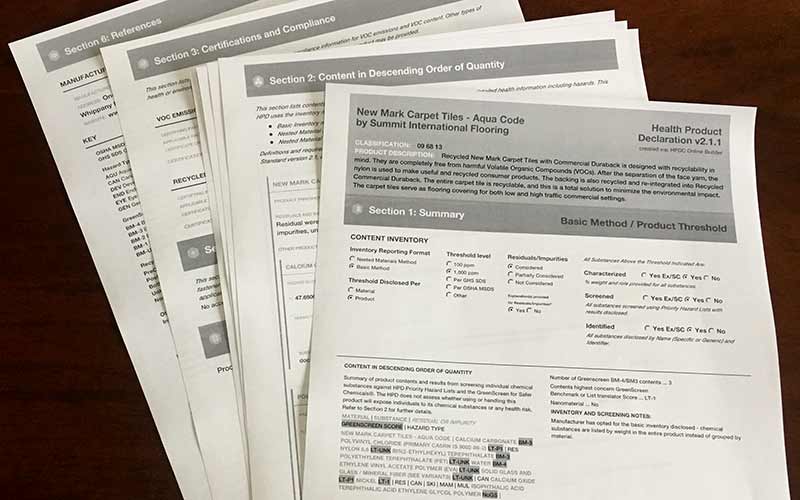Products used in the built environment should meet specific criteria for the health and safety of all occupants. These are called Health Product Declarations (HPDs) and are the standardized way of reporting the contents of your building products. It’s a valuable tool for not only encouraging transparency, it creates a sense of brand trust and is safer for anyone using the property.
Products used in the built environment should meet specific criteria for the health and safety of all occupants. These are called Health Product Declarations (HPDs) and are the standardized way of reporting the contents of your building products. It’s a valuable tool for not only encouraging transparency, it creates a sense of brand trust and is safer for anyone using the property.
What is an HPD?
As the social concern for sustainability, wellness, and health continue to grow, developers have shown an increasing interest for visibility in their products and processes for manufacturing. Health Product Declarations are developed by the instructions set forth by the Health Product Declaration Collaborative and is considered to be complementary to life cycle documentation, like Environmental Product Declarations.
The HPD Open Standard describes the format and directions for reporting your product contents and the related health data. This process is meant as a form of disclosure and does not necessarily mean a product is “healthy.” Rather, it infers it has passed a specific set of standards laid out by the HPD specifications.

HPDs and LEED v4
The latest LEED building certifications were updated to v4 in 2013 by the US Green Building Council as a result of the public's desire for full disclosure of ingredients in building materials. In order to contribute to the Building Product Disclosure for Material Ingredients and Optimization (Material Ingredients) credit of LEED v4, companies need to disclose the ingredients in their products down to 1,000 parts per million. Gathering Health Product Declarations for at least 20 products is one way of earning a LEED point.
HPDs are new to LEED v4 but are one of the ways of documenting ingredients. It’s a flexible tool for meeting the standards and gaining the credits you seek. HPDs published under version 2.1 (and later) offer a means to prescreen for LEED requirements. Health Product Declarations that pass a pre-check can be found in the HPD Public Repository for your convenience. Just use the search bar.
HPDs and Other Sustainability Programs
Since HPDs are used to indicate the health impact of building products, the HPD Open Standard specification works in conjunction with a variety of sustainability programs. This makes sense since they are exposing potential hazards that can affect everything in the surrounding environment. The list includes a growing number of rating and certification standards in the industry, which includes:
- The International WELL Being Institute: This program provides certifications that help leverage WELL’s flexible framework for improving health.
- BIFMA: The trade association for business and institutional furniture manufacturers that has established the safety and development of many performance standards.
- Living Building Challenge: Considered the most rigorous proven performance standard for buildings, this program seeks to create every act of construction and design as something that makes the world a better place.
- Clean Production Action: Running initiatives like the Chemical Footprint Project and GreenScreen for Safer Chemicals, CPA’s mission is to deliver strategic solutions for green.
- Cradle-to-Cradle Product Innovation Institute: “Changing the way we make things” is their motto and this program offers a multitude of services for establishing green standards in your projects.
There are many more to list, but this is a good start when investigating how an HPD Open Standard works with green organizations for easier certification.
How Manufacturers Get an HPD
For many manufacturers, reporting on material health is new territory and obtaining the data needed can be challenging. Professionals working on LEED v4 projects and product manufacturers need to be able to easily navigate “materials disclosure and transparency.” Product manufacturers are responsible for developing the initial HPD and can use the HPD repository to help them select materials that meet LEED requirements.
The HPD Collaborative offers an informative manual specifically for manufacturers seeking to create an HPD. They help companies incorporate health considerations into manufacturing, assembly, and product design. The HPD Open Standard provides the detailed requirements a manufacturer needs to meet in order to qualify for credits.

Using HPDs to Design Healthier Buildings
Empowering your design in the modern age is all about making healthier material choices. The building industry’s leading standard, the HPD Open Standard, is still in the early stages of development and there can be a learning curve when applying it properly.
Luckily, there are certain steps you can take that have proven a success based on experience from real projects. Building designers and developers should pay attention to the following issues during each phase of the venture. These steps will encourage the use of HPDs and ingredient disclosure while meeting the requirements of LEED v4.
Educate the Team and Designate Leaders
If you want your people wholly committed to the project, you must give them context. Take the time to explain the concept of transparency and why it plays an important role in green building. They should know that health concerns over chemicals in building materials are a major interest for buyers and investors.
Pertinent members of the team must understand the drive behind disclosure and work toward a common goal. They should fully understand what HPDs are and how the HPD Open Standard is applied to modern green developments. This can be best achieved by assigning one team member responsibility for maintaining transparency on a consistent basis. Allow them to be the voice for this process.
For LEED v4 projects, familiarize yourself and your team with the LEED Material Ingredients credit as it relates to Health Product Declarations. Make sure you understand exactly what compliance infers and what is expected to meet the standard. Your team must have a full comprehension of what is expected to meet these requirements—including design implications and timeframe.
The Design Phase
Prior to bidding, discussions about HPDs should be had with any party involved, including:
- Owner
- Contractor
- Construction Manager
- Bidders
Make it clear that meeting LEED v4 credit requirements is a key feature on the project. If they need more information, strongly urge them to seek training prior to the start of the project. Training is available through the U.S. Green Building Council’s Education@USGBC platform. You can also instruct the team on specific LEED v4 requirements via the HPDC website.
Since Health Product Declarations are fairly new, there may not be one created for the product you want to use. You can check the HPD Public Repository to determine if one has been written and meets requirements. The LEED credit has specific standards that not all HPDs may meet so it is always best to check.
The Bidding Phase
This is the time when you make sure the contractor understands the importance of selecting products with HPDs for LEED certification. You should choose at least 5-10 more products with HPDs than you need to guarantee quantity compliance. They must also meet the LEED quality compliance requirements. You can use the pre-check tool to do a pre-project scan.
Always keep track of the products for which you have obtained a compliant Health Product Declaration. It’s fairly common to eliminate a variety of items from your list that do not meet LEED v4 standards. That’s why you should start with more than you need; as a buffer.
When you have gathered enough HPDs to meet the quality and quantity required, you should proactively monitor all selection activities and product specification. This will ensure those products remain a part of the project for the entire process. This includes the design and bidding phases.
Make sure you clearly define that, for these specific products, substitutions without HPDs will be rejected. It should be a crucial point to everyone that you are actively pursuing the LEED v4 Material Ingredients credit. This will put your agenda at the forefront of everyone’s mind.
During Construction
This is where you have to be acutely aware of any substitutions. If you are planning for the credit in your overall budget, replacing materials can be disastrous. Always strictly enforce rejections of substitutions on HPD products that meet LEED standards. They are difficult to find as it is, and it will disqualify you from the green acknowledgment.
During construction, keep track of all HPD products that are procured and properly documented on LEED paperwork. If you do not have a LEED consultant on the project, this can be done for internal quality assurance. Documenting the use of these building materials typically falls to the responsibility of the contractor.
Conclusion: Driving New Concepts
The ultimate goal of transparency and full disclosure is to spur further innovation in healthier and safer materials by manufacturers. The market pursues green materials to build with and the public desires to live around them. The LEED pre-check is a great way to save time and money to pre-certify your materials and help you make a more informed decision on behalf of your clients.
Allowing open collaboration of voluntary market participants and programs to enhance the healthfulness of materials improves and optimizes the building environment. The quality of a Health Product Declaration is often judged by the accuracy and completeness of the document. The standards can provide you with the specifications needed to ensure every project you touch is supplied with the greenest materials possible. And that’s a win-win for every party involved.


